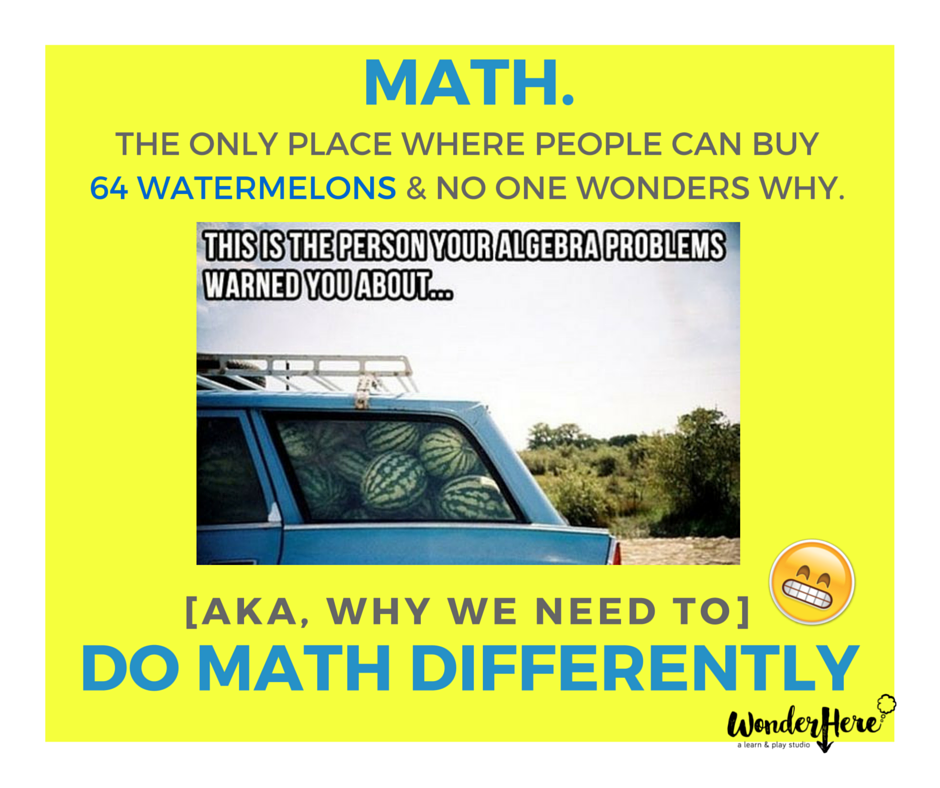Hey there, eager mathematicians 🙂 Last week, I talked about the importance of seeing math differently… realizing there’s more than one way to get to a correct answer, getting kids excited through the inquiry process, and using real world, applicable problems (*ahem* unlike the car-full-of-watermelons scenario… seriously, enough with the overuse of fruit in math, people!).
But I also talked about how the transition from teaching math solely using the traditional approach (i.e. I do it, now you do it the exact same way) to teaching math through inquiry (i.e. Here’s a real life problem, how would you solve it? Okay, now let’s work together to figure it out) can be tough. But with the correct tools, resources, and guidance in place, you’ll be understanding math better than ever before, and having a lot more fun doing it!
So if last week was the why, then this week is the how. I’m going to give you 5 quick tips, tricks, and tools to get you on the road to doing math differently.
- Ditch the workbooks.
Have I lost any of you yet? Don’t go! I’m not saying trash them completely. There is still a time and a place for direct, repetitive practice. I’m just saying, don’t start there. If the first time a child is encountering a math concept is through the lens of a workbook page, we’re never going to capture their interest. Then, when it’s time to apply that skill to a complex, real life word problem, it’s going to hold no value to them. We’ve had it backwards for far too long. Instead of starting with practice problems and then tackling word problems, switch it! Give them a word problem first. Ask them the first step they’d take to solve it. Step back a little and let them struggle. That’s going to help develop that perseverance needed for problem solving. Of course, don’t let them struggle for too long, or unnecessarily. But then, once you’ve worked together to solve that problem and they’ve seen the relevance behind it, have them sharpen those math skills with repetitive practice. - Explore Before Explain / Question Before Tell
This has become somewhat of a theme in my math instruction this year. Here’s the thing, kids know a lot more than we give them credit for sometimes. They have a way of seeing things differently a lot easier than adults. Maybe it’s because we’re set in our ways and “know what we know”. But when I started shifting my teaching mindset and began questioning kids before straight up telling them how it is, I was BLOWN AWAY by their knowledge. I will not lie, I’ve had 3rd graders and 5th graders show me new ways to do math! It’s incredible. So, before bestowing all your knowledge upon them, ask them what they know first. Before explaining exactly how to use specific math tools (like rulers, fraction bars, analog clocks), let them explore them on their own first. See what discoveries they stumble upon. You’ll be surprised what you learn 🙂 - Use Alternative Algorithms
An algorithm is a process or set of rules use to solve a math problem. For example, when subtracting 350-278, people typically use the “borrowing/regrouping” rule to find the answer. Well, to be honest, borrowing is a pain in the behind. I’ve taught 2nd, 3rd, and 5th grade math, and borrowing is consistently one of the concepts students struggle with the most. There are too many steps, and those steps generally mean nothing to them. Yes, that’s the traditional way, but sometimes tradition makes no sense! I learned a quick little trick to remedy this. When subtracting from a number that ends in a “0” (like 350), just take 1 away from each number. So, instead of 350-278, you now solve 349-277. You’ll get the same answer and, voila! No borrowing 🙂 This is just one example of an alternative algorithm. There are so many others! The ones for multiplication and division are especially helpful. Check them out here! - Use REAL WORLD SCENARIOS!
Okay, I’ve hinted at how important this is a couple of times throughout this post, but now I’m really going to talk about it. If you pose a problem to your students or children that involves 64 watermelons, I guarantee you’ll lose them. Maybe externally they’ll feign interest, but deep down inside they’re thinking, when am I ever going to use this? So, I’m going to share with you two great resources for relevant math. First, a program called Front Row where you can make a “teacher” account and corresponding “student” accounts. Some of the content is free, and others are available upon subscription. However, I just have a free account and it’s great! Your kids can take a quick diagnostic test, and it’ll give them adaptive practice based on their ability. There are also inquiry based lessons based on real world problems. Last week, my class pretended to be budding entrepreneurs opening a burger shack, and they used math to learn their sales, expenses, tax, and profits. This week, they are using division to plan a birthday party! Another great resource is Dan Meyer’s site 101 Questions, where he posts random, AWESOME videos and pictures and relates them to math! - Have a Positive Attitude
If you have a positive, “math is fun!” attitude, chance are your kids will adopt that same positivity. They feed off our energy. I regret the years I spent teaching math because I “had to.” Now, I get excited to! When you shift your mindset, I guarantee you’ll start seeing math everywhere. Here’s an example: I was sitting in church the other day and my pastor was talking about dedication and used the analogy of Kobe Bryant going into practice one day from 4am-2pm with the goal of making 8,000 shots. The old me would’ve just glazed over the comment (especially since I’m not a huge sports fanatic), but the math lover in me immediately thought “I wonder how many shots he’d have to make a minute. So I broke out my phone calculator in church (and was elbowed in the side by my husband for doing so), and figured out that he’d have to make about 13 shots a minute. Crazy!
Remember, when math stops being relevant, that’s when we’ve stopped doing our job effectively. I know that sounds dramatic, but it’s true. If we dream of our children having at least the option of becoming engineers, doctors, architects, scientists, astronauts, businessmen and women, then we have to show them now how important math is, and how the skills they’re learning today will get them there.





